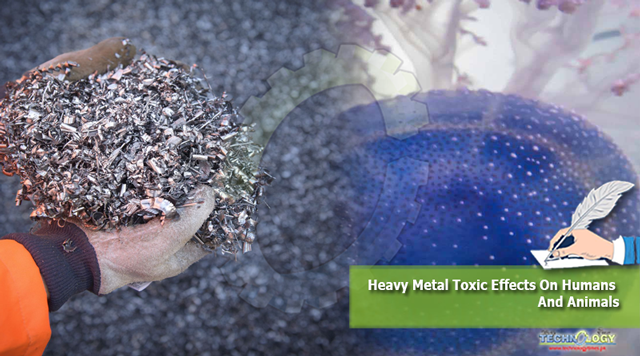Heavy metal absorption by the food chain is an anxious problem throughout the world due to the human health risk and food safety issue.

By :Dr. Maria Jamil1, Dr. Javaria Mashkoor1, Dr. Ali Raza2, Dr. Muhammad Tahir Aleem3
Worldwide food quality, safety, and environmental pollution are the main public health concerns. Heavy metal contamination is a severe hazard due to its bioaccumulation, biodegradation, and toxicity in the food chain. These contaminants have direct Physiological toxic effects due to their storage, and incorporation in tissues might be permanent. The toxic element, when consumed over a long period, is dangerous even at a low ratio. The essential metals are also lead to toxic effects when metal consumed at a very high level. Food is particularly the major mean for the introduction of heavy metals to humans. Meat and meat products are the main sources of the human diet. Heavy metals in chicken meat arise through the adulteration of poultry water, feed, and processing due to natural existence in soil. The risk related to the introduction of heavy metal exists in food products have stimulated the extensive concern in human health. Cadmium and lead are identified as more toxic than all other heavy metals. The mean concentration of magnesium, nickel, chromium, cadmium, and lead in the liver of slaughtered cattle was 76.167, 0.938, 4.775, 2.687, and 1.523 mg/kg, respectively. However, the mean concentration of magnesium, nickel, chromium, cadmium, and lead in the kidney of slaughtered were 68.258, 0.772, 4.894, 2.058, and 0.8442, respectively.
Source of heavy metal contamination:
Mining
Smelting
Agriculture pesticides
Corrosion
Industrial smoke
Waste disposal
Pharmaceutical fertilizer and pesticides industries
Metallurgical industrial waste
Heavy metal charges neurotoxic effects in human:
Television
Paints
Batteries
Electronics
Tap water
Costume jewelry
Lipsticks and compact powder
Cadmium toxicity:
Cadmium is mainly toxic to the kidney, specifically to proximal tubular cells. Through cadmium toxicity, bone demineralization is affected directly through bone injury and indirectly by renal dysfunction.
Lead toxicity:
Through overexposure of lead affects the neurological, renal, reproductive, and hematological systems. Chickens are more infected by lead toxicity than adults. Up to 50% of inhaled inorganic lead may be absorbed in the lungs. Adults take up 10–15% of lead in food, whereas children may absorb up to 50% via the gastrointestinal tract. The half-life of lead in blood is about 1 month and in the skeleton 20–30 years.
Chromium toxicity:
The high level of chromium is measured to be poisonous. The range of chromium in the chicken liver from 0.009-0.091 ppm is non–significant and within the approved tolerance limit. In the environment, chromium exists in various oxidized states ranging from Cr2+ to Cr6+. Generally occurring toxic states of chromium in both humans and plants are Cr3+ to Cr6+. In an environment, chromium is released by fertilizers and sewage.
Copper toxicity:
High level leads to tissue damage. The range of copper in the chicken liver from 0.006-2.54 ppm is non-significant and within the tolerance limit.
Nickel toxicity:
Nickel is found in a small amount in the air, water, soil, and food. Soluble nickel compounds are more toxic than insoluble compounds. When animals or humans consumed nickel up to 5g, it may lead to toxicity. , The side effect of nickel include vomiting, nausea, headache, diarrhea, lung damage, and death. The permissible limit for human and animals was 75 μg per day. Nickel is known to be toxic at high doses, and this will lead to health hazards to both animals and humans. By fertilizers and sewage, Anthrapogenically chromium is released in the environment.
Arsenic toxicity:
Arsenic is a metalloid that exists naturally in oil and water in both organic and inorganic form. Arsenic contamination in drinking water is the main health problem. In Pakistan, typically in southern and central Punjab, the arsenic level at ground level is high. In Sindh arsenic level of groundwater reaches 1100µg/L, while the WHO suggested the limit of arsenic 10µg/L at ground level. Natural sources of arsenic leads to drinking water contamination, including arsenide, sulfides, arsenate, oxides, silicates, and arsenopyrite.
Conclusion:
These heavy metals accumulated in tissues and organs of animals. So when animals are slaughtered for human consumption and other animals, these metals can, in turn, accumulated in humans and other animal tissues and organs.
Dr. Maria Jamil1, Dr. Javaria Mashkoor1, Dr. Ali Raza2, Dr. Muhammad Tahir Aleem3
- Department of Pathology, Faculty of veterinary science, University of Agriculture, Faisalabad
- Department of Microbiology, Faculty of veterinary science, University of Agriculture, Faisalabad
- MOE Joint International Research Laboratory of Animal Health and Food Safety, College of Veterinary Medicine, Nanjing Agricultural University, 210095 Nanjing, P.R.China
